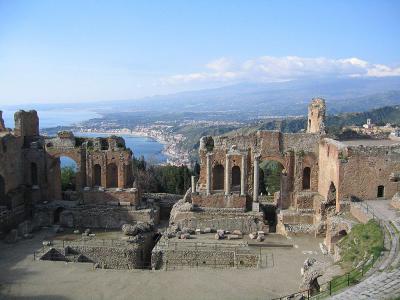Teatro Antico di Taormina (Ancient Theatre of Taormina), Taormina (must see)
The Ancient Theatre of Taormina, set high on a hillside with sweeping views of Mount Etna and the Ionian Sea, is one of Sicily’s most celebrated monuments. Built in the 3rd century BC under the reign of Hiero II of Syracuse, it followed the typical Greek theatre design, with a semicircular cavea carved into the slope and a simple stage used for drama and religious festivals. Constructing it required immense effort, as more than 100,000 cubic meters of rock were manually removed from the mountain. From the beginning, the theatre was not only a cultural center but also a striking blend of architecture and landscape.
In the Roman period, particularly in the 2nd century AD, the theatre was adapted to suit changing tastes. The modest Greek stage was replaced with a monumental scaenae frons adorned with marble columns and statues, while the orchestra area once used by musicians was transformed for gladiatorial contests. The theatre could seat between 5,000 and 5,400 spectators, arranged in nine sections with porticos. Its scale and acoustics made it a favored venue for performances, while its dramatic setting enhanced every spectacle.
During the Middle Ages, the theatre fell into disrepair, but it never lost its allure. Rediscovered in the 18th and 19th centuries by travelers on the Grand Tour, it became renowned as one of the most beautiful ancient theatres in the world. Writers, painters, and aristocrats immortalized its vistas, cementing Taormina’s reputation as a cultural haven.
Today, the Ancient Theatre remains the second-largest in Sicily and is still in use. Since the 1950s, it has hosted concerts, plays, operas, and film festivals. For visitors, walking through its ruins offers both a journey into Sicily’s Greek and Roman past and an unforgettable panorama where history, myth, and natural beauty come together.
In the Roman period, particularly in the 2nd century AD, the theatre was adapted to suit changing tastes. The modest Greek stage was replaced with a monumental scaenae frons adorned with marble columns and statues, while the orchestra area once used by musicians was transformed for gladiatorial contests. The theatre could seat between 5,000 and 5,400 spectators, arranged in nine sections with porticos. Its scale and acoustics made it a favored venue for performances, while its dramatic setting enhanced every spectacle.
During the Middle Ages, the theatre fell into disrepair, but it never lost its allure. Rediscovered in the 18th and 19th centuries by travelers on the Grand Tour, it became renowned as one of the most beautiful ancient theatres in the world. Writers, painters, and aristocrats immortalized its vistas, cementing Taormina’s reputation as a cultural haven.
Today, the Ancient Theatre remains the second-largest in Sicily and is still in use. Since the 1950s, it has hosted concerts, plays, operas, and film festivals. For visitors, walking through its ruins offers both a journey into Sicily’s Greek and Roman past and an unforgettable panorama where history, myth, and natural beauty come together.
Want to visit this sight? Check out these Self-Guided Walking Tours in Taormina. Alternatively, you can download the mobile app "GPSmyCity: Walks in 1K+ Cities" from Apple App Store or Google Play Store. The app turns your mobile device to a personal tour guide and it works offline, so no data plan is needed when traveling abroad.
Teatro Antico di Taormina (Ancient Theatre of Taormina) on Map
Sight Name: Teatro Antico di Taormina (Ancient Theatre of Taormina)
Sight Location: Taormina, Italy (See walking tours in Taormina)
Sight Type: Attraction/Landmark
Guide(s) Containing This Sight:
Sight Location: Taormina, Italy (See walking tours in Taormina)
Sight Type: Attraction/Landmark
Guide(s) Containing This Sight:
Walking Tours in Taormina, Italy
Create Your Own Walk in Taormina
Creating your own self-guided walk in Taormina is easy and fun. Choose the city attractions that you want to see and a walk route map will be created just for you. You can even set your hotel as the start point of the walk.
Taormina Introduction Walking Tour
In 396 BC, the notorious tyrant Dionysius I of Syracuse instructed his commander Andromachus to establish a settlement at the foot of Mount Etna. This came after Dionysius had destroyed the ancient Greek city of Naxos, leaving its displaced inhabitants in need of a new home. The settlement's original name, Tauromenion, meaning “dwelling on the Taurus,” referred to the nearby mountain... view more
Tour Duration: 2 Hour(s)
Travel Distance: 2.0 Km or 1.2 Miles
Tour Duration: 2 Hour(s)
Travel Distance: 2.0 Km or 1.2 Miles




